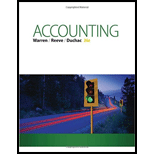
Concept explainers
(a)
Net present value method is the method which is used to compare the initial
The net present value of the project.
(b)
To explain: The rate of return based on the analysis.
(c)
Internal rate of return method is one of the capital investment methods which determine the rate of return, wherein the net present value of all the cash flows (both positive and negative) from an investment is zero. This method is also called as the time-adjusted rate of return method. It used to evaluate the different proposal’s expected rate of return.
The internal rate of return for the given project
Want to see the full answer?
Check out a sample textbook solution
Chapter 26 Solutions
ACCOUNTING-W/CENGAGENOWV2 ACCESS
- Please help me correct the wrong answers:Depreciation expense cant be: 11k or 12,625arrow_forwardSolve this problem quarrow_forwardA company’s debt-to-equity ratio is calculated by dividing:a) Total Assets by Total Equityb) Total Liabilities by Total Equityc) Total Debt by Total Equity d) Total Revenue by Total Equityarrow_forward
 Managerial AccountingAccountingISBN:9781337912020Author:Carl Warren, Ph.d. Cma William B. TaylerPublisher:South-Western College Pub
Managerial AccountingAccountingISBN:9781337912020Author:Carl Warren, Ph.d. Cma William B. TaylerPublisher:South-Western College Pub Financial And Managerial AccountingAccountingISBN:9781337902663Author:WARREN, Carl S.Publisher:Cengage Learning,
Financial And Managerial AccountingAccountingISBN:9781337902663Author:WARREN, Carl S.Publisher:Cengage Learning,

